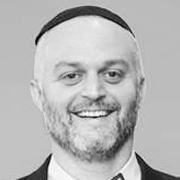Making a Tea Party

Rabbi Avi Katz Orlow
In considering the desired outcomes of Jewish education, I recall a classic debate from my time in yeshiva: What makes tea sweet? Is it the sugar or the stirring? In the context of this discussion, we can ask the same question: What is more important? Is it the Jewish content (the sugar) or the process of developing Jewish identity (the stirring)?
Clearly the arguments of Abraham and Sarah written by Drs. Jon A. Levisohn and Jeffrey S. Kress are hyperbolic. But, the optimal design of Jewish educational experiences is contingent on where an educator weighs in on this continuum. Based on my traditional educational background, Sarah’s perspective rings true. But my tenure working in Jewish camps and on college campuses with Hillel has developed my appreciation for Abraham’s perspective. That said, before I weigh in on where I fall on this sugar/stirring continuum, there is an even more salient question: Do people even want tea?
Outside of the context of true tea lovers, how is the construct of Jewish developmental outcomes any more or less artificial than a possibly outdated and irrelevant canon of Jewish content/practice? To play out the metaphor further, because I am rather old-fashioned when it comes to my enjoyment of high tea, the student side of me does not have many complaints. As a Jewish educator, however, I realize that my personal preferences are irrelevant. If we genuinely are interested in opening up the market, we will need to be flexible on both sides of this equation. I suggest that we are challenged today to explore our various beliefs around what constitutes Jewish content and to blur the lines of traditional Jewish identity markers.
To this point, revelation is not limited to something that might or might not have happened long ago at Sinai; it is something that is happening in the learning experience itself today. As we learn from Rabbi Yehoshua ben Levi:
Every day a heavenly voice goes forth from Mount Horev and makes proclamation . . . And it says, “And the tablets were the work of God, and the writing was the writing of God, graven upon the tablets” (Exodus 32:16). Read not harut (graven) but herut (freedom). For there is no free man but one that occupies himself with the study of the Torah. (Avot 6:2)
Textual learning is therefore integrated in and is a manifestation of the relationships in our lives. In this context, all learners can access and feel ownership over Jewish text. The Torah is not static, fixed, or engraved in stone, but, rather, free to evolve with us if we commit ourselves to its study.
In my experience, people often describe successful Jewish educational experiences as “life changing.” Like Abraham, the focus of this education is its relevance, personal transformation, and individual growth. Whereas the course of study in formal educational environments often follows the text, the opposite often happens in experiential education. For Sarah, text plays the role of reacting to, commenting on, and transforming the students’ narratives. As the Jewish philosopher Franz Rosenzweig said, “It is learning in reverse order, a learning that no longer starts from the Torah and leads into life, but the other way around: from life . . . back to the Torah.” My prescription then, or recipe, is that the educator needs to trust the educational process. Like the two teams who excavated Hezekiah’s Tunnel, starting at each end of the tunnel and then meeting in the middle, experiential educators must negotiate the tension between reacting to students’ revelations and forcing them to reach the canon of “big ideas.” That is to say, the educator needs to maintain the trust of the students and fidelity with the tradition; constantly negotiating the two.
I find that students’ experiences of this dynamic tension are often their first proper tea. But there is still much work to reimagining the canon of Jewish practices and content. The Abraham in this fake debate and the Abraham we encounter in the Bible are both asking us to be iconoclastic and break free of our preconceptions of authentic Jewish content.
The Men of the Great Assembly said, “Be cautious in judgment. Establish many students. And make a safety fence around the Torah” (Avot 1:1). I see the value of maintaining a fence around the Torah for the students we have now. But what about for the students we may lose due to the perception of Torah’s irrelevance to their lives? Are we willing to break through these fences to bring in new students? It is incumbent upon us to investigate whether we are willing and able to imagine an education where Judaism actually speaks to Jews.
The decision has important implications for all of us who devote ourselves to preparing and consuming a proper spot of tea. A shift away from the primacy of revelation to the accessibility of a Torah of relevance might put stress on our assumptions that we are “one people with one Torah.” At the same time, throwing off the tyranny of classical Judaism may allow more Jews today to take an active role in making Jewish life meaningful. We might even call it a tea party.
Rabbi Avi Katz Orlow is the vice president, program and innovation, for the Foundation for Jewish Camp. He has served as the campus rabbi and assistant director of the St. Louis Hillel at Washington University and has held numerous positions as rabbi, educator, and youth leader. He spent 17 years as a camper and then educator at Ramah camps in Pennsylvania and Wisconsin and YUSSR camps in the former Soviet Union. Avi has a BA in religious studies from Columbia University. He was ordained in the charter class at Yeshivat Chovevei Torah, the open Orthodox rabbinical school.



